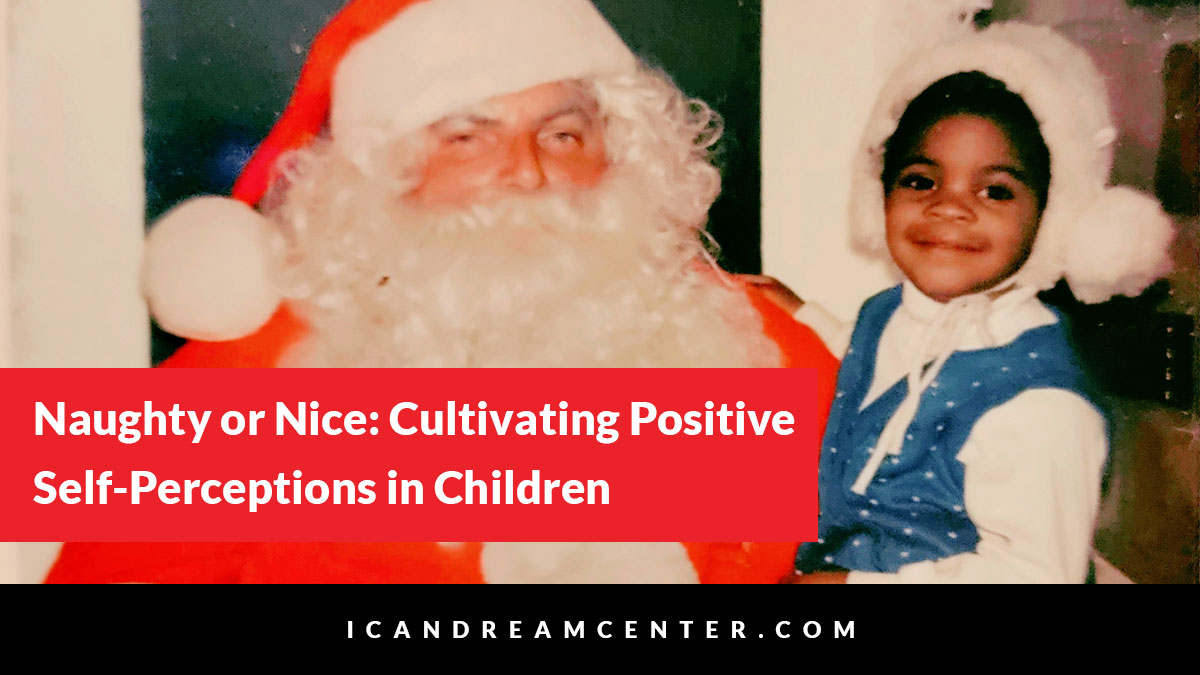
Naughty or Nice: Cultivating Positive Self-Perceptions in Children
By: Dr. Evisha Ford, LCSW
I stumbled upon this photo recently and smiled. Instantly, it brought back warm memories of the most wonderful time of the year. December was a particularly festive month in my family. My birthday is in December, my maternal grandmother’s birthday was on Christmas, both my maternal aunts had December birthdays, not to mention my cousin (who is more like a sister!). I remember the holiday seasons of my youth so fondly with enough family gatherings and cake to fill our hearts (and stomachs) for the year.

The next thought that came to me is that despite my festive smile, I was always most certainly on the “naughty list” as a child.
My behavior would have been tough for anyone to handle– from swearing to biting; I applaud my parents because they never reflected their frustration to me.
But the photo still makes me think about how I had internalized the feedback that I received about my mischievousness. I felt extremely loved by my family, and yet still came to understand that I was a “bad kid.”
Even as a child, I understood that this was only one dimension of my personality because while my family freely expressed their feelings about my undesirable behavior, I was also celebrated for being intelligent, outgoing, and wise beyond my years.
I pondered the impact my childhood self- perception and I thought that it is possible that some of what I experienced as a child may not have occurred if I had understood myself differently then.
As a young child, I was physically abused at the daycare I attended. I can recall being strapped into a seat for extended periods. I also have vivid memories of the employees removing my shoes and socks and striking the bottoms of my feet!
One morning, I was with a cousin dropping her son at the same daycare when his normally calm demeanor noticeably transformed into terror as he gained a view of his destination. I casually stated, “I know why he doesn’t want to go…” and shared what happed to me some five years prior. I was moved to speak up in that moment because, in my mind, my younger cousin was a good boy, and he shouldn’t have been subject to poor treatment. I hadn’t shared when I was experiencing those atrocities because I understood it as appropriate for “bad kids.”
A different internal narrative could have saved me, and countless other children, from suffering.
My experience fuels my passion, advocacy, and creative program design to ensure that children, particularly those with challenging behaviors, receive exceptional care. My healing planted the first tiny seed of purpose (i.e., to use my voice to help others) that eventually flourished into the iCan Dream Center.
Parents and educators are positioned to help children to form a positive identity. My hope is that my story will serve as a call to action to be intentional with your words and actions.
Here is some framework for cultivating a positive self-perception for children.
• Affirm. Affirm children for the positive attributes that you witness in them. As humans, we have a bent toward success, and children will often attempt to replicate what is celebrated. Neurodiverse children tend to have a higher threshold for what registers in their brain as a reward; more is required for the dopamine response that creates a neuropathway. This means you may have to validate “excessively” what is good and positive.
• Connect. Be students of your children and those that you serve. We must be acquainted enough with their habits and inclinations to notice changes. Ask questions and listen closely to the response. Do not mistake quantity of time for quality time; simply spending extended time in a shared room does not mean there is a connection. Being truly seen and heard by trusted adults provides assurance that a child matters. This sets the tone for healthy relationships across the lifespan. Plan to spend 15 minutes daily in a conversation that is led by the youth, giving them focused attention (read: not multitasking on a cellphone), asking follow-up questions to gain clarity. This is not the time for advising, but rather, a time to simply hold a space. If your child or learner is nonverbal, this is modified by engaging in play, allowing the child to choose the preferred activities.
• Be mindful. When unexpected behavior occurs, it is our job to name it and teach more productive behavior. I am in complete disagreement with a parenting style that takes the path of least resistance and permits (thereby implicitly reinforces) children behaving poorly. Wisdom that I gleaned from the amazing book Four Arrows in My Hand was to ask yourself if the witnessed behavior will be acceptable or humous in 15 years and if not, it requires correction. Of course, the correction will consider the child’s abilities and complex needs. However, the goal is always to focus on the negative behavior, not the child. We must be deliberate about stating “that behavior is inappropriate” rather than “you are a naughty.” Similarly, we must be mindful of the declarations that we make over children. I have heard frequent comments about children, (from parents!) like “he’s manipulative,” “he is a little jerk, “or “she’s so bossy.” When I am frustrated, I work hard to reframe statements to my sons, for example, opting to say, “we are still working on being honest” rather than “you are a liar.” I know it is cliché, but it is worth stating, your words have power!
• Be well. Children learn to cope with their emotions from parents, teachers, and caregivers. Adults are always modeling! When you are angry, anxious, tired, or otherwise dysregulated, the children are taking cues on how to behave. Children are keen observers of behavior, but terrible interpreters. The best thing you can do is to self-reflect and learn to calm yourself so that you are responding, rather than reacting, to children (and other adults!). Additionally, children often internalize a caregivers’ fit of rage, and it inadvertently reinforces their own negative self-perceptions. As adults, we must learn how to restore our own sense of calm during intense moments. This may look like asking for a break, praying, or sitting alone in the car to regroup. It also means establishing practices that support wellness like recharging–planning time with loved ones, sticking to a sleep routine, and preparing for adequate nourishment and hydration. Being well may also mean seeking counseling or other support services.
As we make our lists this month (and check them twice!), let’s make sure children understand that while their behavior may be naughty at times, they are indeed worthy of being treated well, known and seen as NICE! The children in our care are worth the effort it takes to try a new approach! Children with a positive identity matriculate into adulthood understanding that they are valued, prepared to participate in healthy relationships, and willing to take risks. Let’s give that gift in all the seasons of a child’s life.
